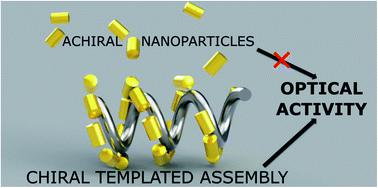当前位置:
X-MOL 学术
›
Chem. Sci.
›
论文详情
Our official English website, www.x-mol.net, welcomes your
feedback! (Note: you will need to create a separate account there.)
Template-assisted self-assembly of achiral plasmonic nanoparticles into chiral structures
Chemical Science ( IF 7.6 ) Pub Date : 2021-09-28 , DOI: 10.1039/d1sc03327a David Vila-Liarte 1, 2 , Nicholas A Kotov 3, 4 , Luis M Liz-Marzán 1, 2, 5
Chemical Science ( IF 7.6 ) Pub Date : 2021-09-28 , DOI: 10.1039/d1sc03327a David Vila-Liarte 1, 2 , Nicholas A Kotov 3, 4 , Luis M Liz-Marzán 1, 2, 5
Affiliation

|
The acquisition of strong chiroptical activity has revolutionized the field of plasmonics, granting access to novel light–matter interactions and revitalizing research on both the synthesis and application of nanostructures. Among the different mechanisms for the origin of chiroptical properties in colloidal plasmonic systems, the self-assembly of achiral nanoparticles into optically active materials offers a versatile route to control the structure–optical activity relationships of nanostructures, while simplifying the engineering of their chiral geometries. Such unconventional materials include helical structures with a precisely defined morphology, as well as large scale, deformable substrates that can leverage the potential of periodic patterns. Some promising templates with helical structural motifs like liquid crystal phases or confined block co-polymers still need efficient strategies to direct preferential handedness, whereas other templates such as silica nanohelices can be grown in an enantiomeric form. Both types of chiral structures are reviewed herein as platforms for chiral sensing: patterned substrates can readily incorporate analytes, while helical assemblies can form around structures of interest, like amyloid protein aggregates. Looking ahead, current knowledge and precedents point toward the incorporation of semiconductor emitters into plasmonic systems with chiral effects, which can lead to plasmonic–excitonic effects and the generation of circularly polarized photoluminescence.
中文翻译:

模板辅助将非手性等离子体纳米颗粒自组装成手性结构
强手性光学活性的获得彻底改变了等离子体激元领域,为新型光-物质相互作用提供了机会,并振兴了纳米结构的合成和应用研究。在胶体等离子体系统中手性光学性质起源的不同机制中,非手性纳米粒子自组装成光学活性材料提供了控制纳米结构的结构-光学活性关系的通用途径,同时简化了其手性几何形状的工程。这种非常规材料包括具有精确定义形态的螺旋结构,以及可以利用周期性图案潜力的大规模可变形基材。一些具有螺旋结构图案(如液晶相或受限嵌段共聚物)的有前途的模板仍然需要有效的策略来指导优先旋性,而其他模板(如二氧化硅纳米螺旋)可以以对映体形式生长。本文综述了两种类型的手性结构作为手性传感的平台:图案化的基质可以很容易地掺入分析物,而螺旋组装体可以围绕感兴趣的结构形成,如淀粉样蛋白聚集体。展望未来,当前的知识和先例表明,将半导体发射器纳入具有手性效应的等离子体系统中,这可以导致等离子体激子效应并产生圆偏振光致发光。
更新日期:2021-09-28
中文翻译:

模板辅助将非手性等离子体纳米颗粒自组装成手性结构
强手性光学活性的获得彻底改变了等离子体激元领域,为新型光-物质相互作用提供了机会,并振兴了纳米结构的合成和应用研究。在胶体等离子体系统中手性光学性质起源的不同机制中,非手性纳米粒子自组装成光学活性材料提供了控制纳米结构的结构-光学活性关系的通用途径,同时简化了其手性几何形状的工程。这种非常规材料包括具有精确定义形态的螺旋结构,以及可以利用周期性图案潜力的大规模可变形基材。一些具有螺旋结构图案(如液晶相或受限嵌段共聚物)的有前途的模板仍然需要有效的策略来指导优先旋性,而其他模板(如二氧化硅纳米螺旋)可以以对映体形式生长。本文综述了两种类型的手性结构作为手性传感的平台:图案化的基质可以很容易地掺入分析物,而螺旋组装体可以围绕感兴趣的结构形成,如淀粉样蛋白聚集体。展望未来,当前的知识和先例表明,将半导体发射器纳入具有手性效应的等离子体系统中,这可以导致等离子体激子效应并产生圆偏振光致发光。









































 京公网安备 11010802027423号
京公网安备 11010802027423号